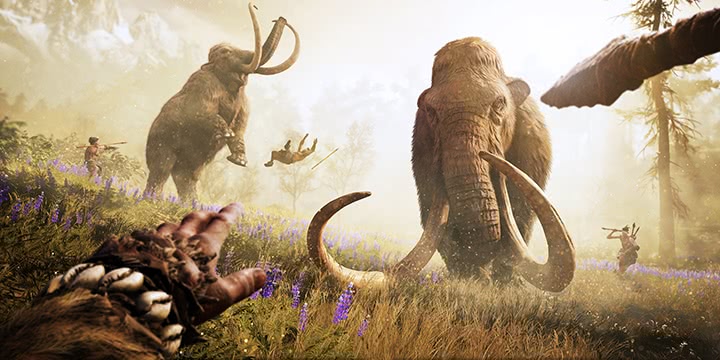Far Cryhas long been an incredibly well-established gaming franchise. Despite changes in location, fans always knew what they were signing up for – cool weapons and vehicles, a strong male protagonist and a reliable combat system.
Ubisoft is now turning the brand on its head with its latest addition to the franchise, Far Cry Primal. Guns are replaced with clubs and bows, alongside extinct mammoths and a heavy focus on crafting. Lead writer Kevin Shortt says he’s taking players “back to the Stone Age, back to our roots”.
The open-world adventure is set in 10,000 BC in the fictional Oros Valley. Our protagonist is Takkar, a Wenja tribesman who has been separated from his people and left to fend for himself. His goal is not only to survive, but to rebuild his tribe. Like most Far Cry games, our hero manages to overcome these odds and rise to power, this time through his unique ability that allows him to tame wild animals. It may seem like an odd idea for a Far Cry game, but Shortt makes a good argument for it.
“Far Cry has always been set on the frontier, and we see this setting as being the very first frontier. The Wenja believe in nature and that everything has a spirit, which makes Takkar incredibly valuable to them throughout the game. He has this unique ability, Beastmaster, meaning that he can tame animals and he uses that to survive. It was something that was actually started in the last Far Cry where you could control the Tiger.”
He continues, “When we had the idea of the Stone Age we thought about how men evolved from prey to being at the top of the food chain, and it was by taming the animals.” (Side note – at a recent playthrough of Far Cry Primal I also discovered that snow leopards aren’t just good weapons, but also super fun to pat constantly.)
Far Cry has always placed an emphasis on giving players the freedom to explore and truly enjoy their surroundings and the gameplay in their own personal way. However, despite removing the multiplayer feature from Primal, the development team has strived to make up for this by truly embracing the open world sandbox concept.
“In Primal it is up to you, the player, what you want to do and where you want to go,” says Shortt. “Past Far Cry games have been more linear, so this is going to be a little different, even with the main missions. There is an end and you’ll get a sense that the game is done, but the world is still available to explore after you’ve finished the story.”
One of the most fascinating and standout aspects of Far Cry Primal is its use of language. Being set in a prehistoric context, utilising the English tongue would seem wrong and jarring. Instead the developers created their own language, named after the primary tribe of the game, Wenja.
“One of the first things we talked about was language and we actually tried recording in English, but when it came to actually telling the story it just felt wrong to say to do it in English or any other modern language, so we got linguists in to help us create a language. They based it on Proto-Indo-European, which is where all [today’s] languages come from. To go into the studio and hear the actors speaking Wenja was so exciting – they made a real language for us and everyone got on board with it.”
Far Cry Primal is outTuesday February 23 on PS4 and Xbox One.

































